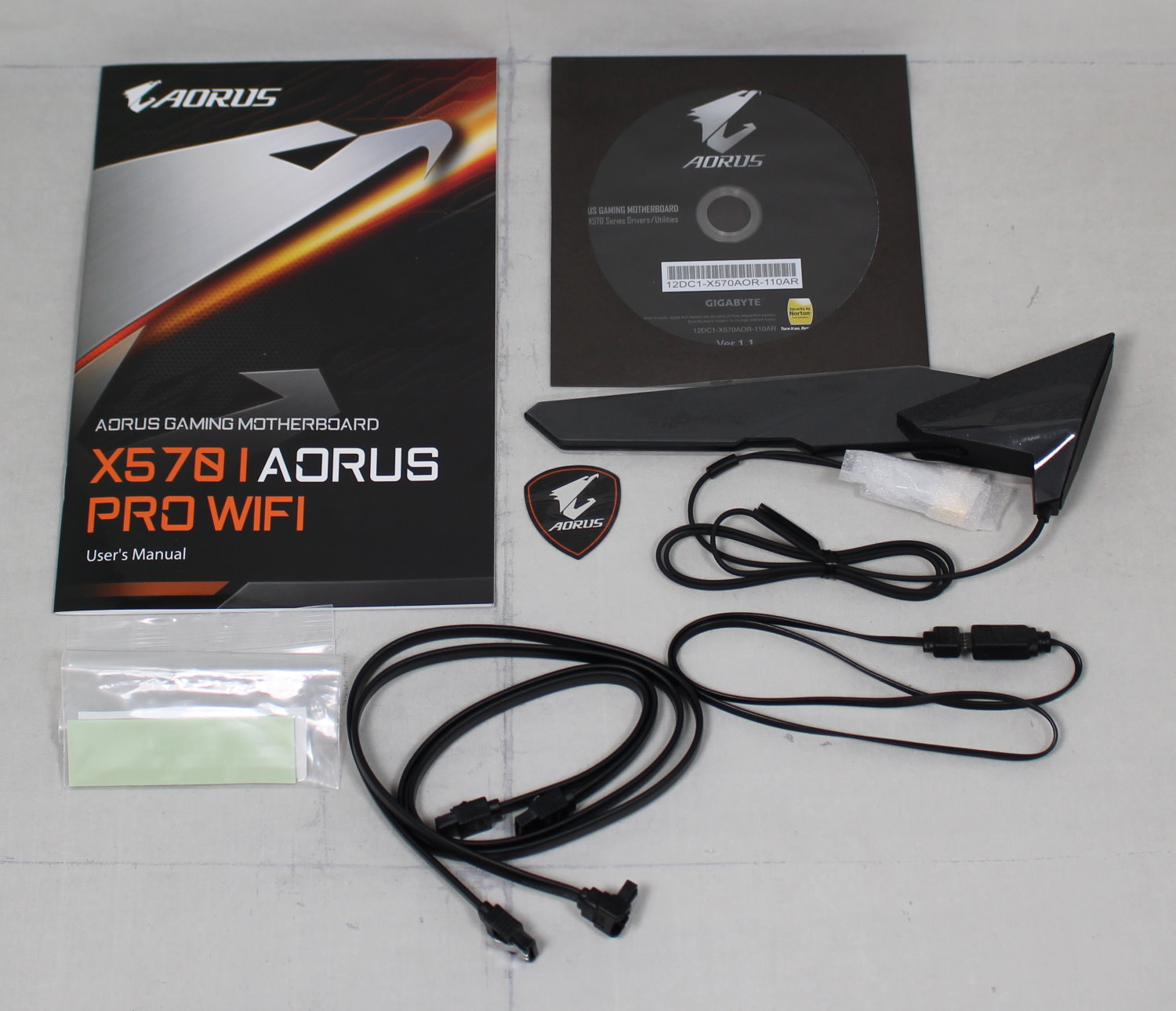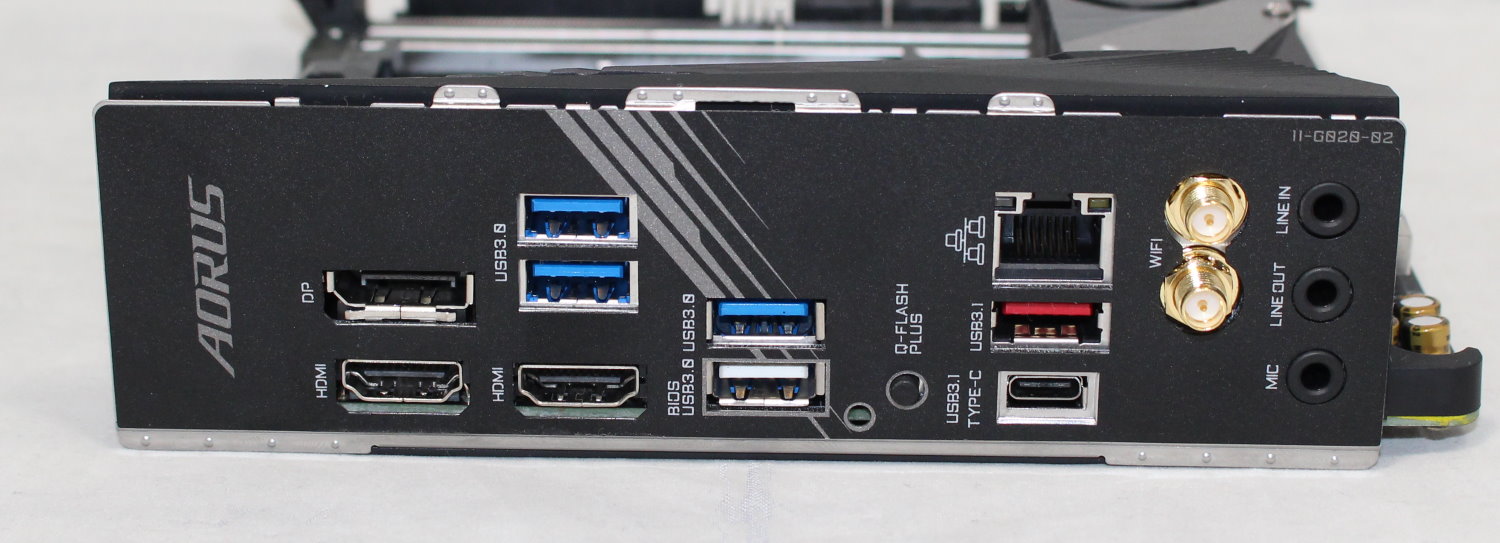Tom's Hardware Verdict
The Gigabyte X570-I Aorus Pro WiFi performed well at stock and when overclocking. The board’s claim to fame is incorporating dual M.2 slots on the ITX form factor which no other board (at least that we know of) does. It includes two USB 3.1 Gen 2 ports on the rear IO (one Type-C, the other Type-A), with six in total. Overall, for the $220 price tag, this tiny board offers users a great assortment of features and is a well-rounded solution for a small form factor board, undercutting the competition.
Pros
- +
Low price for the feature set
- +
USB 3.1 Gen2 Type-C port on rear IO
- +
Two M.2 slots
- +
Q-Flash Plus for easy BIOS updates
Cons
- -
3-plug audio stack
- -
Only two fan headers
Why you can trust Tom's Hardware
Features and Specifications
Gigabyte’s X570-I Aorus Pro Wi-Fi is a compact, Mini-ITX board made for small-form-factor builds that’s capable of handling anything from an HTPC to a full-fledged gaming rig, depending on the hardware installed. It includes dual M.2 slots, fast RAM support, as well as a USB 3.1 Gen 2 Type-C port in back, rivaling some full-size ATX alternatives.
The X570-I also includes a solid 8-phase digital VRM, WiFi 6 support, 7.1 channel Realtek ALC1220-VB premium audio codec, and fast memory support up to DDR4 4400(OC). Priced at $219.99 on Newegg.com, it undercuts the ITX ASRock X570 Phantom Gaming-ITX/TB3 that we recently reviewed by about $20.
Gigabyte’s Aorus boards are the company’s gaming and enthusiast lineup, usually including features such as RGB LEDs, metal “armor” on the DIMM and/or PCIe slots, electrostatic discharge (ESD) guards, along with more of a focus on styling. The X570-I Aorus Pro Wi-Fi embodies the Aorus ethos, while also offering an array of functionality at a very reasonable price point. If ITX isn’t for you, Gigabyte’s X570 lineup includes all sizes and a wide range of price points, from the entry-level X570 UD to the flagship X570 Aorus Xtreme offering a bit of something for everyone. We saw most of the company’s X570 lineup for the first time at Computex 2019 earlier this year.
Like other X570 boards, the Gigabyte Aorus X570-I Aorus Pro Wi-Fi supports both Ryzen 2000 and Ryzen 3000 series processors and includes four SATA ports, two PCIe 4.0 x4 M.2 slot on the back. Its two DIMM slots are capable of supporting up to 64GB of DDR4 RAM, with overclock speeds up to a fast DDR4 4400 MHz. For networking and audio, we find an Intel GbE NIC and Realtek ALC1220-VB audio codec which runs 7.1 surround. Below is a complete list of specifications from Gigabyte.
Specifications
| Socket | AM4 |
| Chipset | AMD X570 |
| Form Factor | ITX |
| Voltage Regulator | 8 Phase (6+2) |
| Video Ports | HDMI 2.0 DisplayPort |
| USB Ports | USB 3.2 Gen 2 (10 Gbps): 1x Type-A (red) USB 3.1 Gen 1 (5 Gbps): 4x Type-A |
| Network Jacks | (1) Gigabit Ethernet |
| Audio Jacks | (3) Analog |
| Legacy Ports/Jacks | ✗ |
| Other Ports/Jack | ✗ |
| PCIe x16 | (1) v4.0 |
| PCIe x8 | ✗ |
| PCIe x4 | ✗ |
| PCIe x1 | ✗ |
| CrossFire/SLI | ✗ |
| DIMM slots | (2) DDR4 - DDR4 4400(OC) |
| M.2 slots | (2) PCIe 4.0 x4 / SATA + PCIe |
| U.2 Ports | ✗ |
| SATA Ports | (4) 6Gb/s |
| USB Headers | (1) v3.x Gen1, (1) USB v2.0 |
| Fan Headers | (2) 4-Pin |
| Legacy Interfaces | ✗ |
| Other Interfaces | FP-Audio, 2x RGB-LED headers |
| Diagnostics Panel | ✗ |
| Internal Button/Switch | ✗ / ✗ |
| SATA Controllers | ✗ |
| Ethernet Controllers | Intel GbE |
| Wi-Fi / Bluetooth | Wi-Fi 6 - Wireless 802.11ax / Bluetooth 5.0 |
| USB Controllers | ✗ |
| HD Audio Codec | Realtek ALC 1220-VB |
| DDL/DTS Connect | ✗ / ✗ |
| Warranty | 3 Years |
Like all boards, Gigabyte includes an accessory stack with the purchase of the board. These stacks have been shrinking over the years, but Gigabyte still provides us with what we need to get started. Below is a list of what is included in the box with this board.
- User Manual
- Support/driver DVD
- 2T2R Wi-Fi antenna
- Two SATA cables
- Thermal pad for M.2 drive
- Gigabyte sticker
- RGB LED extension cable


The board itself is black all around, including the connectivity ports and VRM heatsink with its brushed-aluminum finish. The rear IO sports an integrated IO plate giving the inexpensive board a more premium feel. The chipset heatsink doubles as the first M.2 slot and comes with a fan to help keep the chipset and M.2 drive below (assuming you’ve installed one) cool. This stacking shouldn’t be an issue to keep both the chipset and M.2 module cool, but isn’t optimal. But again, given the size of this board, there isn’t a whole lot of room for features that take up as much space as an M.2 drive.
Both the PCIe and DIMM slots are reinforced by Gigabyte’s Ultra Durable PCIe and Memory Armor, protecting the slots from heavy components. The chipset heatsink itself has a lined portion as well as brushed-aluminum styling, which shows off the familiar Aorus falcon branding. RGB illumination comes from eight LEDs on the right side of the board and is controlled by the company’s RGB Fusion 2.0 software.
Get Tom's Hardware's best news and in-depth reviews, straight to your inbox.
Overall, the styling here is reserved (especially considering the garish Aorus boards from a few years ago) and will fit with almost any build theme. If the included RGB lighting isn’t enough, there are additional headers onboard to connect to.
For full-size boards, we normally split it up into the top and bottom half and focus on each. But with a Mini-ITX board, there really isn’t a point as the board is so small.
Focusing in on the left side to start, we can see the VRM heatsink and integrated rear IO plate dominating that are. The VRM heatsink has a lot of mass and kept the power bits underneath running cool during stock and overclocked testing. Outside of the brushed-aluminum finish, we see the Aorus name in chrome on the top.
Sending power to the VRM is a single 8-Pin connector, located in the top-left corner next to one (of two) fan headers. This delivers power to what Gigabyte says is an 8-phase VRM. In this case, it is a true 8-phase VRM, not using phase doublers to get there and including a high-quality Infineon IR35201 8-phase (6+2) controller. This setup proved to handle stock and overclocking our Ryzen 7 3700X with ease and should handle the higher core count chips as well.
To the right of the socket are the armored DIMM slots, which support up to DDR4 4400 (OC). This isn’t quite as high as the 4533 MHz rating we saw on the ASRock ITX board, but this board doesn’t have the integrated circuit (IC) clearance issues we saw on ASRock’s ITX board. And clocking memory much above 3600MHz on this platform results in very minimal performance gains (at best) anyway. The DIMM slots on the Aorus board use a single-sided locking mechanism, which is likely a cost-cutting measure. But the single-side setup is actually is my preferred setup, versus both sides locking.
To the right of the socket, we see the 24-pin ATX power connector, front panel header, four SATA3 6 Gbps ports (supporting RAID 0, 1, 5, and 10), along with USB 3.0 and USB 2.0 headers. Flanking the DIMM slots towards the bottom are the two RGB LED headers (3-pin ARGB and 4-pin) supporting standard 5050 RGB strips. This is a curious location for these headers, but AIBs do what they need to do to shoehorn features into these compact boards with extremely limited real estate.
Also in that area is the second fan header. Note that either fan header supports both PWM- or DC- controlled devices. We would like to have seen one more fan header on the board, but again, space is tight. Any connected fans can be controlled through the Smart Fan 5 software in Windows or from the BIOS. Both worked without issue in our testing.
The bottom portion of the board is taken over by the large chipset and M.2 heatsink, located just above the full-length PCIe 4.0 x16 slot. Using the latest BIOS (F4j), the chipset fan remained quiet during our testing and kept the chipset at reasonable temperatures.
Last, to the left of the chipset heatsink is the front audio header, along with a Trusted Platform Module (TPM) header.
We don’t talk about the back of motherboards much, as typically the only items worth noting are any phase doublers or perhaps an I/O chip for monitoring. In this case, the board sports an integrated base plate for increased rigidity. It’s also where the second M.2 slot is located, this one without a heatsink. Both M.2 slots support PCIe and SATA-based modules up to 80mm length.
Overall, Gigabyte’s board layout is as good as it can be considering the lack of physical space at play here. Two M.2 slots on a board this size is quite good, and likely will be useful to more users than a Thunderbolt 3 port like that found on the more-expensive ASRock X570 ITX board.
The rear IO consists of an integrated IO panel and continues the black theme, giving it a more premium look than the typical flimsy snap-in IO panels. Ports on the back consist of two HDMI 2.0 ports and a DisplayPort for video output (for use with AMD’s APUs). As for USB, there’s a total count of six, with two USB 3.2 Gen 2 ports (Type-A red, and Type-C), along with four USB 3.0 ports -- blue, with the Q-Flash Plus port white. To the right of this port is the Q-Flash Plus button. We see the Intel-based LAN port, WiFi 6 antenna 2T2R connectors, and the three-plug audio stack. I have to admit I was a bit surprised not to see the full 5-plug plus SPDIF outputs here. But again, most people will likely be plugging in stereo or 2.1-chanel audio with a couple of speakers and a sub.
Outside of the audio stack, there’s plenty of connectivity around back. While six USB ports aren’t the most we’ve seen, it should be enough for a small form factor board to get by, especially when also using the front panel headers.
MORE: Best Motherboards
MORE: How To Choose A Motherboard
MORE: All Motherboard Content

Joe Shields is a staff writer at Tom’s Hardware. He reviews motherboards and PC components.
-
logainofhades I have been using this board, with a 3700x, pretty much since launch week. No complaints here.Reply -
Jyeung0690 I’m going to be building and I’m stuck on if I need an ARGB splitter or just an RGB splitter 3pin or 4pin. I’m assuming I’m going to need a splitter for sure but trying to figure out how to make all the ARGB to work.Reply -
SonoraTechnical This board was perfect, until it didn't have SPDIF / Optical Audio Out. Bummer!Reply

